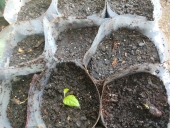
 4
4




Pecan Media: food forestry and forest garden ebooks
Now available: The Native Persimmon (centennial edition)
 2
2








A build too cool to miss:Mike's GreenhouseA great example:Joseph's Garden
All the soil info you'll ever need:
Redhawk's excellent soil-building series









greg mosser wrote:both a friend and i have grown pawpaws from seed in full-sun nursery beds. i think 50% die-off is overstated, i don’t think less than 75% of mine made it. i have frequently said that i suspect the ‘common knowledge’ of young pawpaw seedlings needing shade was parroted more from earlier sources than from experience.













greg mosser wrote:
i wonder if different populations from different places will act differently....




greg mosser wrote:trace, did those plants leaf out under cover and then get uncovered, or were they out in the sun before they leafed out?
i wonder if different populations from different places will act differently....





 1
1














 1
1




Other people may reject you but if you lie in the forest floor for long enough the moss and fungi will accept you as one of their own!
 2
2





| I agree. Here's the link: http://stoves2.com |




